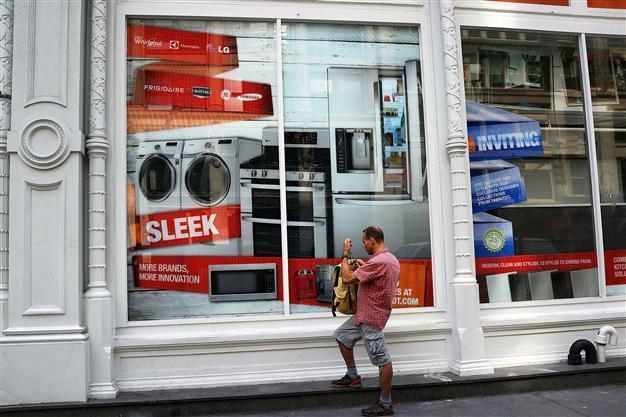US growth still 'modest to moderate': Fed's Beige Book
WASHINGTON - Agence France-Presse

AFP Photo
US economic growth has held firm at a "modest to moderate" pace since July, with activity steady or gaining in most sectors, the Federal Reserve's Beige Book review said Wednesday.In a report likely to support a move soon toward lower stimulus spending by the Fed, most of its 12 regions reported that consumer spending, travel, manufacturing and demand for services had risen since the previous survey.
Job creation was also steady or improved, and inflation was under control around the country, the report said.
"For most occupations and industries, hiring held steady or increased modestly relative to the prior reporting period," it said.
"Upward price pressures remained subdued, and prices increased slightly during the reporting period. Wage pressures continued to be modest overall." As a picture of steady growth, the survey could contribute to a decision by the Fed's policy board, the Federal Open Market Committee, to begin cutting back on its stimulus program as early as its next meeting, on September 17-18.
The Fed has been signaling the coming drawdown of its $85 billion a month bond-buying stimulus, or quantitative easing, since May, saying reducing the program was contingent on the economy continuing to improve broadly.
Recent data has mostly backed that. July trade figures released Wednesday supported the view of moderate growth, after the 2.5 percent pace achieved in the second quarter.
And car sales accelerated in August to an estimated 17 percent year-over-year growth pace, according to industry figures out Wednesday.
But deciding to begin tapering the stimulus program likely will hinge more on the US jobs market, with fresh data for job creation and the unemployment rate in August to be released on Friday.
Most analysts are predicting the Friday data will show little change from the July jobs situation, when a modest 162,000 net new jobs were recorded, with the jobless rate at 7.4 percent.
For Erik Johnson, senior US economist at IHS Global Insight, that will not likely be enough for a tapering announcement this month.
"Our view remains that the unemployment rate will dictate the Fed's quantitative easing.
"The labor market was too uncertain for the Fed to taper in late July and developments since then haven't settled the matter. As such, we don't anticipate tapering at the September meeting, but expect tapering at the December meeting and a gradual winding down of asset purchases through the first half of 2014." Most of the signs in the Beige Book survey were positive: reports from eight of the 12 districts characterized the pace of economic activity as "moderate", while the other four called it "modest" or, in one, the Chicago region, "improved". Despite a rise in interest rates, residential real estate activity was growing still, and non-residential property business also "gained overall". Consumer spending growth was slow, driven in part by demand for cars, home furnishings and home improvement goods.
However, it said, consumers appear to remain "cautious in their purchases and highly price-sensitive." Ongoing federal spending cutbacks were not having much impact overall on the economy, with the exception of the hospitality business, with several regions noting a decline in travel by government officials.
Still, there were signs of weakness. With the exception of mortgage financing for home purchases, loan growth slowed from the previous reporting period, and was flat in a number of areas. In addition, farm production in some areas was hit by continuing drought; in others, mainly in the southeast, high rainfall had delayed planting.
US stock markets, which have seen any sign of economic strength as a sign of coming interest rate rises, were unmoved by the report, the broad S&P 500 index holding onto its 0.8 percent gain after the release.
Treasury bond yields, an indicator of the direction of interest rates, held to early gains, with the 10-year bond hitting 2.90 percent, compared with 1.63 percent at the beginning of May.
















